The teachers can build a rain forest
VerifiedAdded on 2022/08/26
|8
|2432
|11
AI Summary
Contribute Materials
Your contribution can guide someone’s learning journey. Share your
documents today.
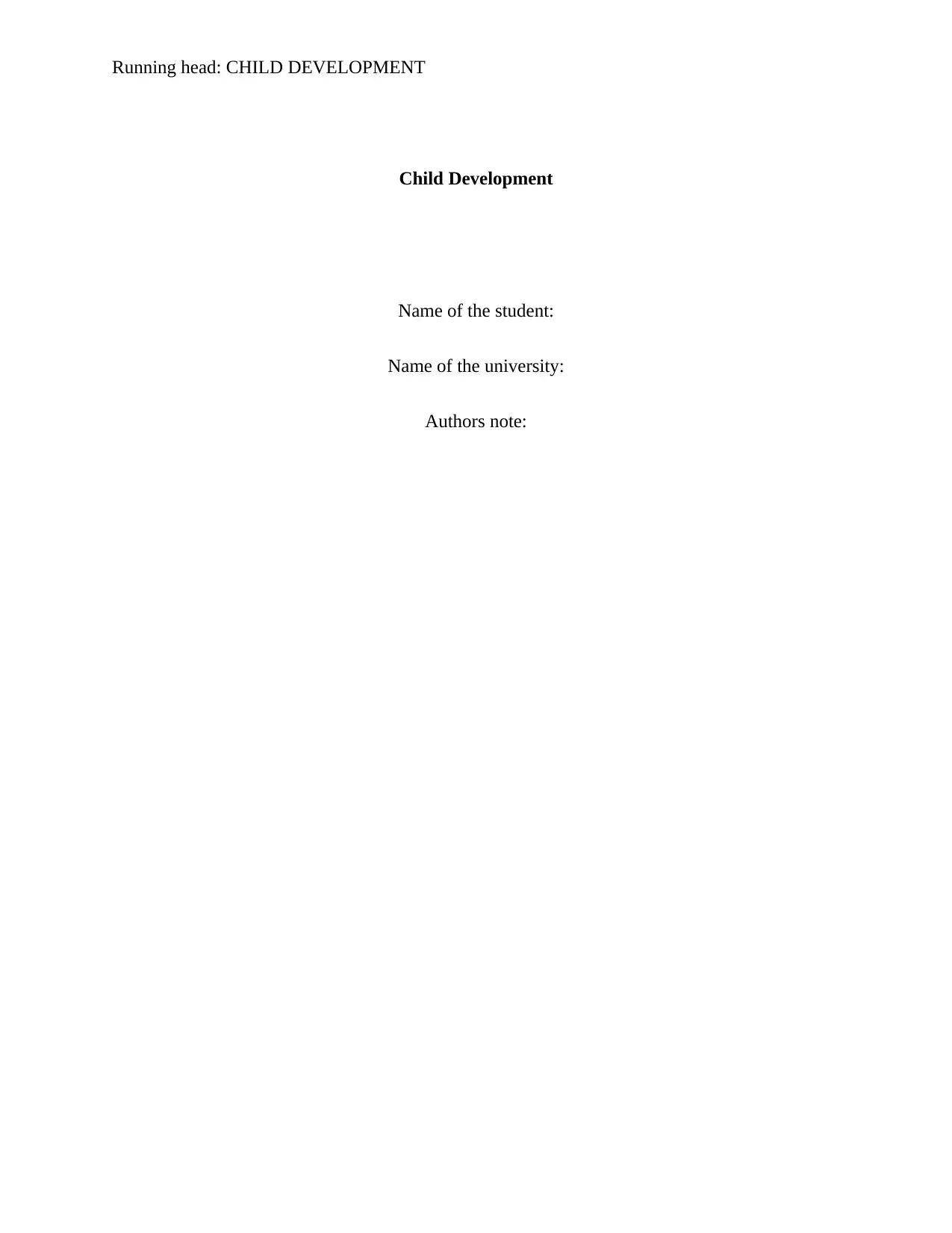
Running head: CHILD DEVELOPMENT
Child Development
Name of the student:
Name of the university:
Authors note:
Child Development
Name of the student:
Name of the university:
Authors note:
Secure Best Marks with AI Grader
Need help grading? Try our AI Grader for instant feedback on your assignments.
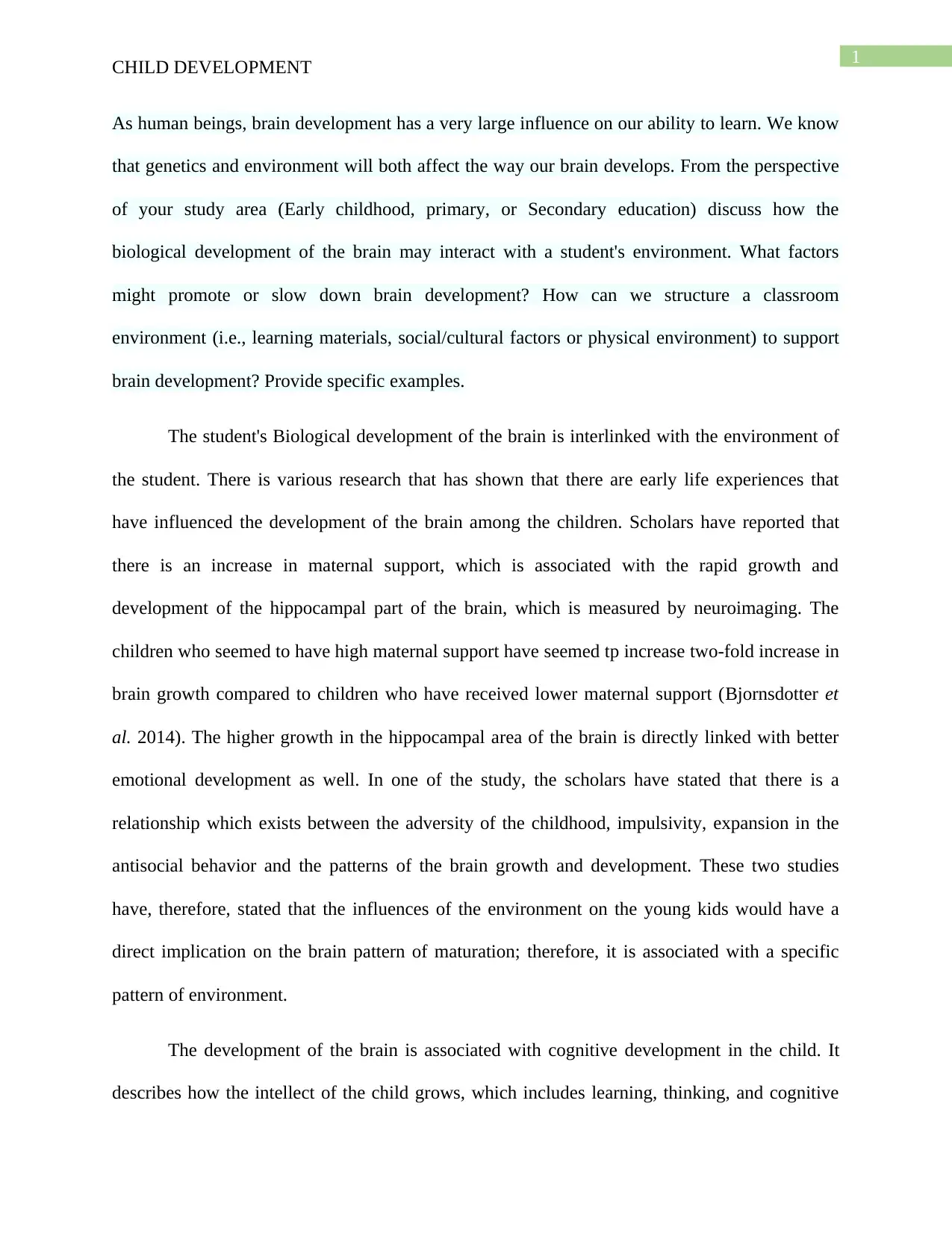
1
CHILD DEVELOPMENT
As human beings, brain development has a very large influence on our ability to learn. We know
that genetics and environment will both affect the way our brain develops. From the perspective
of your study area (Early childhood, primary, or Secondary education) discuss how the
biological development of the brain may interact with a student's environment. What factors
might promote or slow down brain development? How can we structure a classroom
environment (i.e., learning materials, social/cultural factors or physical environment) to support
brain development? Provide specific examples.
The student's Biological development of the brain is interlinked with the environment of
the student. There is various research that has shown that there are early life experiences that
have influenced the development of the brain among the children. Scholars have reported that
there is an increase in maternal support, which is associated with the rapid growth and
development of the hippocampal part of the brain, which is measured by neuroimaging. The
children who seemed to have high maternal support have seemed tp increase two-fold increase in
brain growth compared to children who have received lower maternal support (Bjornsdotter et
al. 2014). The higher growth in the hippocampal area of the brain is directly linked with better
emotional development as well. In one of the study, the scholars have stated that there is a
relationship which exists between the adversity of the childhood, impulsivity, expansion in the
antisocial behavior and the patterns of the brain growth and development. These two studies
have, therefore, stated that the influences of the environment on the young kids would have a
direct implication on the brain pattern of maturation; therefore, it is associated with a specific
pattern of environment.
The development of the brain is associated with cognitive development in the child. It
describes how the intellect of the child grows, which includes learning, thinking, and cognitive
CHILD DEVELOPMENT
As human beings, brain development has a very large influence on our ability to learn. We know
that genetics and environment will both affect the way our brain develops. From the perspective
of your study area (Early childhood, primary, or Secondary education) discuss how the
biological development of the brain may interact with a student's environment. What factors
might promote or slow down brain development? How can we structure a classroom
environment (i.e., learning materials, social/cultural factors or physical environment) to support
brain development? Provide specific examples.
The student's Biological development of the brain is interlinked with the environment of
the student. There is various research that has shown that there are early life experiences that
have influenced the development of the brain among the children. Scholars have reported that
there is an increase in maternal support, which is associated with the rapid growth and
development of the hippocampal part of the brain, which is measured by neuroimaging. The
children who seemed to have high maternal support have seemed tp increase two-fold increase in
brain growth compared to children who have received lower maternal support (Bjornsdotter et
al. 2014). The higher growth in the hippocampal area of the brain is directly linked with better
emotional development as well. In one of the study, the scholars have stated that there is a
relationship which exists between the adversity of the childhood, impulsivity, expansion in the
antisocial behavior and the patterns of the brain growth and development. These two studies
have, therefore, stated that the influences of the environment on the young kids would have a
direct implication on the brain pattern of maturation; therefore, it is associated with a specific
pattern of environment.
The development of the brain is associated with cognitive development in the child. It
describes how the intellect of the child grows, which includes learning, thinking, and cognitive
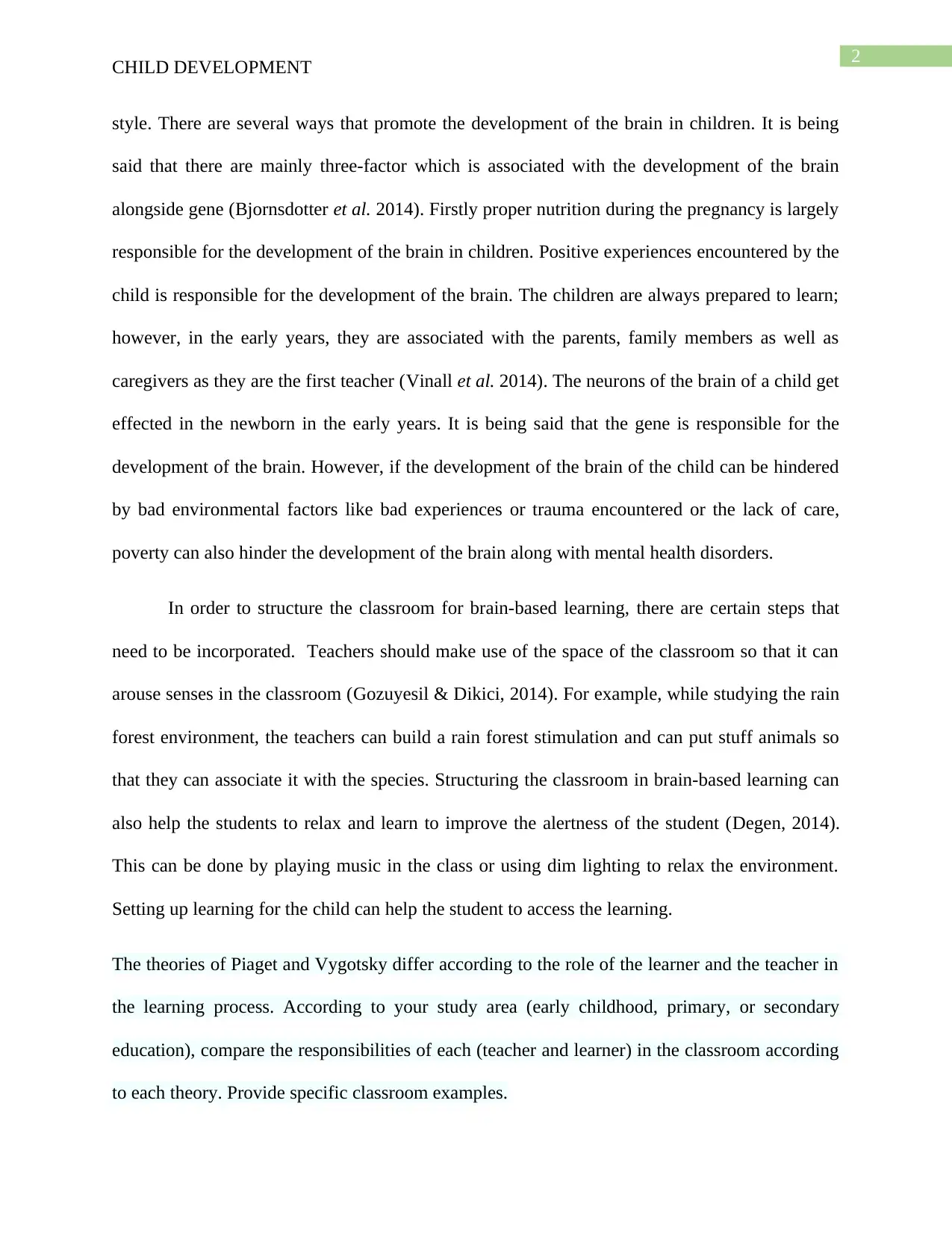
2
CHILD DEVELOPMENT
style. There are several ways that promote the development of the brain in children. It is being
said that there are mainly three-factor which is associated with the development of the brain
alongside gene (Bjornsdotter et al. 2014). Firstly proper nutrition during the pregnancy is largely
responsible for the development of the brain in children. Positive experiences encountered by the
child is responsible for the development of the brain. The children are always prepared to learn;
however, in the early years, they are associated with the parents, family members as well as
caregivers as they are the first teacher (Vinall et al. 2014). The neurons of the brain of a child get
effected in the newborn in the early years. It is being said that the gene is responsible for the
development of the brain. However, if the development of the brain of the child can be hindered
by bad environmental factors like bad experiences or trauma encountered or the lack of care,
poverty can also hinder the development of the brain along with mental health disorders.
In order to structure the classroom for brain-based learning, there are certain steps that
need to be incorporated. Teachers should make use of the space of the classroom so that it can
arouse senses in the classroom (Gozuyesil & Dikici, 2014). For example, while studying the rain
forest environment, the teachers can build a rain forest stimulation and can put stuff animals so
that they can associate it with the species. Structuring the classroom in brain-based learning can
also help the students to relax and learn to improve the alertness of the student (Degen, 2014).
This can be done by playing music in the class or using dim lighting to relax the environment.
Setting up learning for the child can help the student to access the learning.
The theories of Piaget and Vygotsky differ according to the role of the learner and the teacher in
the learning process. According to your study area (early childhood, primary, or secondary
education), compare the responsibilities of each (teacher and learner) in the classroom according
to each theory. Provide specific classroom examples.
CHILD DEVELOPMENT
style. There are several ways that promote the development of the brain in children. It is being
said that there are mainly three-factor which is associated with the development of the brain
alongside gene (Bjornsdotter et al. 2014). Firstly proper nutrition during the pregnancy is largely
responsible for the development of the brain in children. Positive experiences encountered by the
child is responsible for the development of the brain. The children are always prepared to learn;
however, in the early years, they are associated with the parents, family members as well as
caregivers as they are the first teacher (Vinall et al. 2014). The neurons of the brain of a child get
effected in the newborn in the early years. It is being said that the gene is responsible for the
development of the brain. However, if the development of the brain of the child can be hindered
by bad environmental factors like bad experiences or trauma encountered or the lack of care,
poverty can also hinder the development of the brain along with mental health disorders.
In order to structure the classroom for brain-based learning, there are certain steps that
need to be incorporated. Teachers should make use of the space of the classroom so that it can
arouse senses in the classroom (Gozuyesil & Dikici, 2014). For example, while studying the rain
forest environment, the teachers can build a rain forest stimulation and can put stuff animals so
that they can associate it with the species. Structuring the classroom in brain-based learning can
also help the students to relax and learn to improve the alertness of the student (Degen, 2014).
This can be done by playing music in the class or using dim lighting to relax the environment.
Setting up learning for the child can help the student to access the learning.
The theories of Piaget and Vygotsky differ according to the role of the learner and the teacher in
the learning process. According to your study area (early childhood, primary, or secondary
education), compare the responsibilities of each (teacher and learner) in the classroom according
to each theory. Provide specific classroom examples.
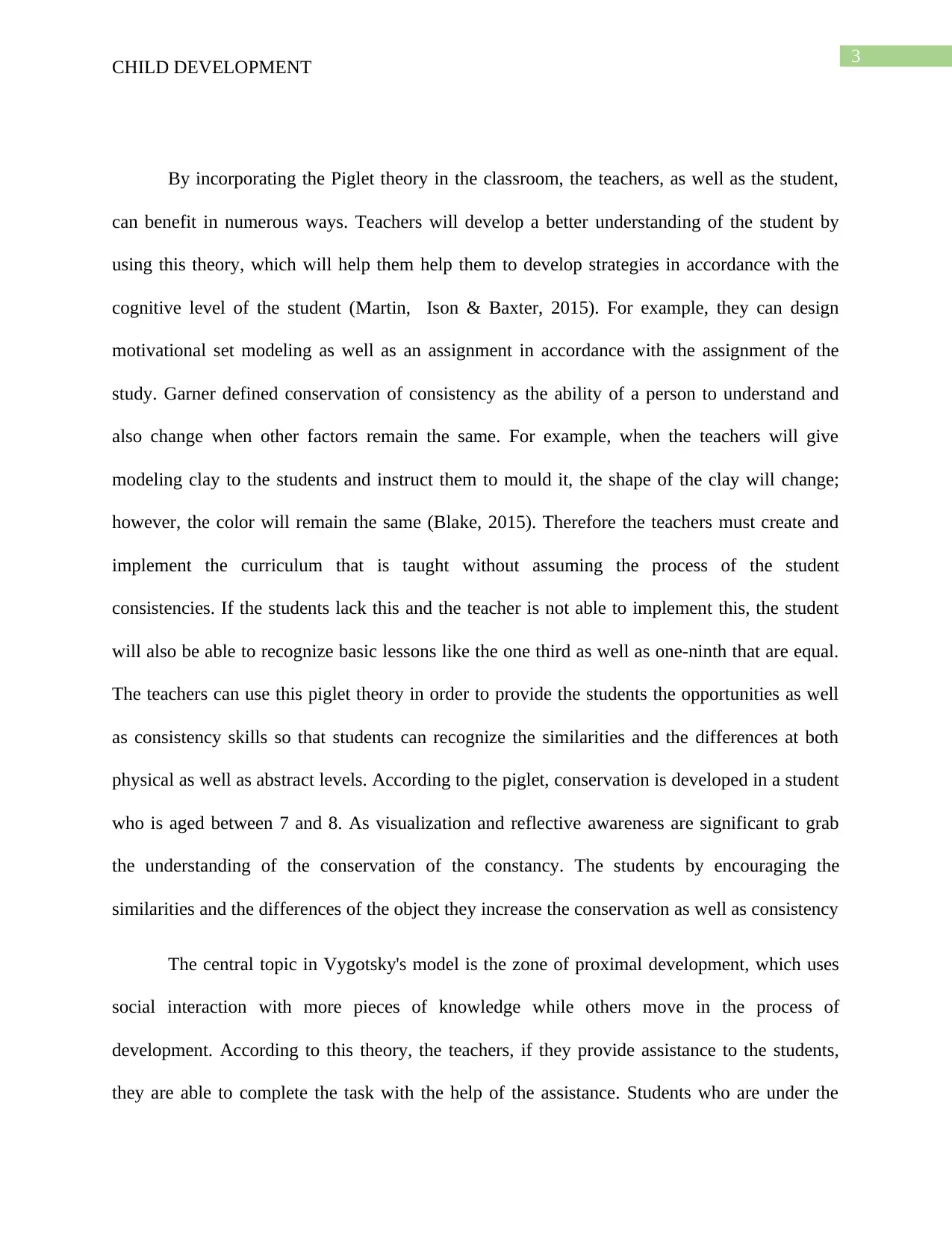
3
CHILD DEVELOPMENT
By incorporating the Piglet theory in the classroom, the teachers, as well as the student,
can benefit in numerous ways. Teachers will develop a better understanding of the student by
using this theory, which will help them help them to develop strategies in accordance with the
cognitive level of the student (Martin, Ison & Baxter, 2015). For example, they can design
motivational set modeling as well as an assignment in accordance with the assignment of the
study. Garner defined conservation of consistency as the ability of a person to understand and
also change when other factors remain the same. For example, when the teachers will give
modeling clay to the students and instruct them to mould it, the shape of the clay will change;
however, the color will remain the same (Blake, 2015). Therefore the teachers must create and
implement the curriculum that is taught without assuming the process of the student
consistencies. If the students lack this and the teacher is not able to implement this, the student
will also be able to recognize basic lessons like the one third as well as one-ninth that are equal.
The teachers can use this piglet theory in order to provide the students the opportunities as well
as consistency skills so that students can recognize the similarities and the differences at both
physical as well as abstract levels. According to the piglet, conservation is developed in a student
who is aged between 7 and 8. As visualization and reflective awareness are significant to grab
the understanding of the conservation of the constancy. The students by encouraging the
similarities and the differences of the object they increase the conservation as well as consistency
The central topic in Vygotsky's model is the zone of proximal development, which uses
social interaction with more pieces of knowledge while others move in the process of
development. According to this theory, the teachers, if they provide assistance to the students,
they are able to complete the task with the help of the assistance. Students who are under the
CHILD DEVELOPMENT
By incorporating the Piglet theory in the classroom, the teachers, as well as the student,
can benefit in numerous ways. Teachers will develop a better understanding of the student by
using this theory, which will help them help them to develop strategies in accordance with the
cognitive level of the student (Martin, Ison & Baxter, 2015). For example, they can design
motivational set modeling as well as an assignment in accordance with the assignment of the
study. Garner defined conservation of consistency as the ability of a person to understand and
also change when other factors remain the same. For example, when the teachers will give
modeling clay to the students and instruct them to mould it, the shape of the clay will change;
however, the color will remain the same (Blake, 2015). Therefore the teachers must create and
implement the curriculum that is taught without assuming the process of the student
consistencies. If the students lack this and the teacher is not able to implement this, the student
will also be able to recognize basic lessons like the one third as well as one-ninth that are equal.
The teachers can use this piglet theory in order to provide the students the opportunities as well
as consistency skills so that students can recognize the similarities and the differences at both
physical as well as abstract levels. According to the piglet, conservation is developed in a student
who is aged between 7 and 8. As visualization and reflective awareness are significant to grab
the understanding of the conservation of the constancy. The students by encouraging the
similarities and the differences of the object they increase the conservation as well as consistency
The central topic in Vygotsky's model is the zone of proximal development, which uses
social interaction with more pieces of knowledge while others move in the process of
development. According to this theory, the teachers, if they provide assistance to the students,
they are able to complete the task with the help of the assistance. Students who are under the
Secure Best Marks with AI Grader
Need help grading? Try our AI Grader for instant feedback on your assignments.
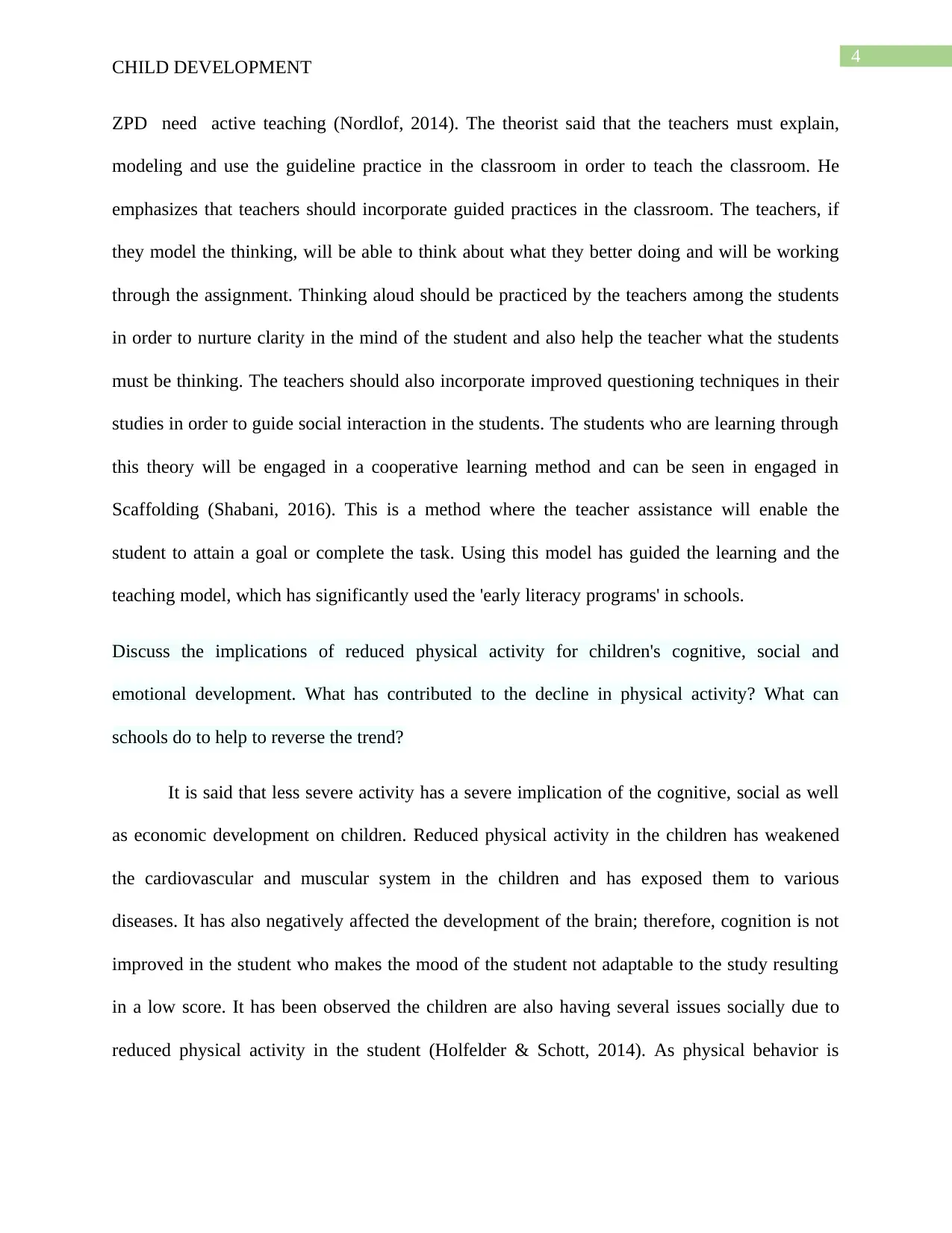
4
CHILD DEVELOPMENT
ZPD need active teaching (Nordlof, 2014). The theorist said that the teachers must explain,
modeling and use the guideline practice in the classroom in order to teach the classroom. He
emphasizes that teachers should incorporate guided practices in the classroom. The teachers, if
they model the thinking, will be able to think about what they better doing and will be working
through the assignment. Thinking aloud should be practiced by the teachers among the students
in order to nurture clarity in the mind of the student and also help the teacher what the students
must be thinking. The teachers should also incorporate improved questioning techniques in their
studies in order to guide social interaction in the students. The students who are learning through
this theory will be engaged in a cooperative learning method and can be seen in engaged in
Scaffolding (Shabani, 2016). This is a method where the teacher assistance will enable the
student to attain a goal or complete the task. Using this model has guided the learning and the
teaching model, which has significantly used the 'early literacy programs' in schools.
Discuss the implications of reduced physical activity for children's cognitive, social and
emotional development. What has contributed to the decline in physical activity? What can
schools do to help to reverse the trend?
It is said that less severe activity has a severe implication of the cognitive, social as well
as economic development on children. Reduced physical activity in the children has weakened
the cardiovascular and muscular system in the children and has exposed them to various
diseases. It has also negatively affected the development of the brain; therefore, cognition is not
improved in the student who makes the mood of the student not adaptable to the study resulting
in a low score. It has been observed the children are also having several issues socially due to
reduced physical activity in the student (Holfelder & Schott, 2014). As physical behavior is
CHILD DEVELOPMENT
ZPD need active teaching (Nordlof, 2014). The theorist said that the teachers must explain,
modeling and use the guideline practice in the classroom in order to teach the classroom. He
emphasizes that teachers should incorporate guided practices in the classroom. The teachers, if
they model the thinking, will be able to think about what they better doing and will be working
through the assignment. Thinking aloud should be practiced by the teachers among the students
in order to nurture clarity in the mind of the student and also help the teacher what the students
must be thinking. The teachers should also incorporate improved questioning techniques in their
studies in order to guide social interaction in the students. The students who are learning through
this theory will be engaged in a cooperative learning method and can be seen in engaged in
Scaffolding (Shabani, 2016). This is a method where the teacher assistance will enable the
student to attain a goal or complete the task. Using this model has guided the learning and the
teaching model, which has significantly used the 'early literacy programs' in schools.
Discuss the implications of reduced physical activity for children's cognitive, social and
emotional development. What has contributed to the decline in physical activity? What can
schools do to help to reverse the trend?
It is said that less severe activity has a severe implication of the cognitive, social as well
as economic development on children. Reduced physical activity in the children has weakened
the cardiovascular and muscular system in the children and has exposed them to various
diseases. It has also negatively affected the development of the brain; therefore, cognition is not
improved in the student who makes the mood of the student not adaptable to the study resulting
in a low score. It has been observed the children are also having several issues socially due to
reduced physical activity in the student (Holfelder & Schott, 2014). As physical behavior is
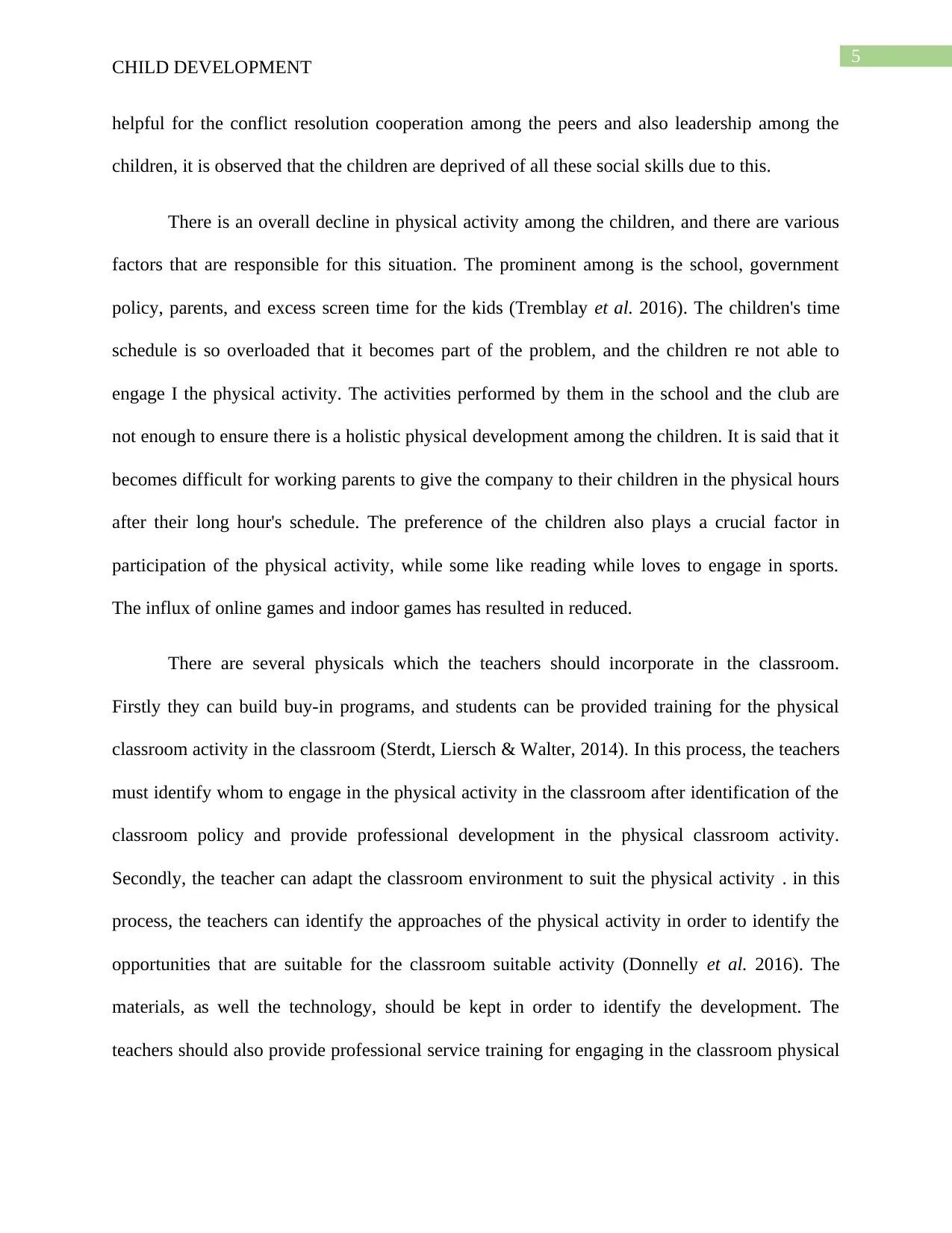
5
CHILD DEVELOPMENT
helpful for the conflict resolution cooperation among the peers and also leadership among the
children, it is observed that the children are deprived of all these social skills due to this.
There is an overall decline in physical activity among the children, and there are various
factors that are responsible for this situation. The prominent among is the school, government
policy, parents, and excess screen time for the kids (Tremblay et al. 2016). The children's time
schedule is so overloaded that it becomes part of the problem, and the children re not able to
engage I the physical activity. The activities performed by them in the school and the club are
not enough to ensure there is a holistic physical development among the children. It is said that it
becomes difficult for working parents to give the company to their children in the physical hours
after their long hour's schedule. The preference of the children also plays a crucial factor in
participation of the physical activity, while some like reading while loves to engage in sports.
The influx of online games and indoor games has resulted in reduced.
There are several physicals which the teachers should incorporate in the classroom.
Firstly they can build buy-in programs, and students can be provided training for the physical
classroom activity in the classroom (Sterdt, Liersch & Walter, 2014). In this process, the teachers
must identify whom to engage in the physical activity in the classroom after identification of the
classroom policy and provide professional development in the physical classroom activity.
Secondly, the teacher can adapt the classroom environment to suit the physical activity . in this
process, the teachers can identify the approaches of the physical activity in order to identify the
opportunities that are suitable for the classroom suitable activity (Donnelly et al. 2016). The
materials, as well the technology, should be kept in order to identify the development. The
teachers should also provide professional service training for engaging in the classroom physical
CHILD DEVELOPMENT
helpful for the conflict resolution cooperation among the peers and also leadership among the
children, it is observed that the children are deprived of all these social skills due to this.
There is an overall decline in physical activity among the children, and there are various
factors that are responsible for this situation. The prominent among is the school, government
policy, parents, and excess screen time for the kids (Tremblay et al. 2016). The children's time
schedule is so overloaded that it becomes part of the problem, and the children re not able to
engage I the physical activity. The activities performed by them in the school and the club are
not enough to ensure there is a holistic physical development among the children. It is said that it
becomes difficult for working parents to give the company to their children in the physical hours
after their long hour's schedule. The preference of the children also plays a crucial factor in
participation of the physical activity, while some like reading while loves to engage in sports.
The influx of online games and indoor games has resulted in reduced.
There are several physicals which the teachers should incorporate in the classroom.
Firstly they can build buy-in programs, and students can be provided training for the physical
classroom activity in the classroom (Sterdt, Liersch & Walter, 2014). In this process, the teachers
must identify whom to engage in the physical activity in the classroom after identification of the
classroom policy and provide professional development in the physical classroom activity.
Secondly, the teacher can adapt the classroom environment to suit the physical activity . in this
process, the teachers can identify the approaches of the physical activity in order to identify the
opportunities that are suitable for the classroom suitable activity (Donnelly et al. 2016). The
materials, as well the technology, should be kept in order to identify the development. The
teachers should also provide professional service training for engaging in the classroom physical
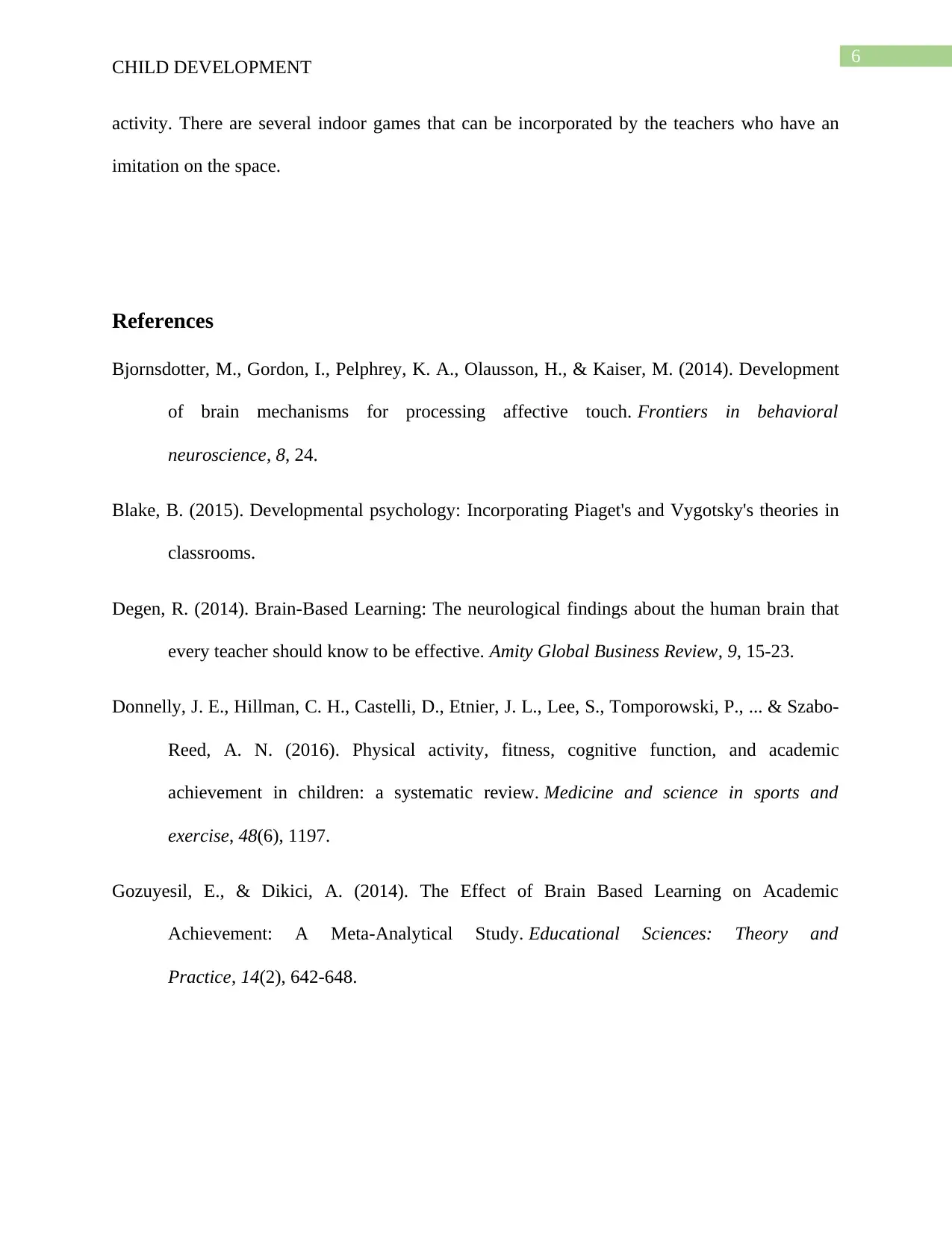
6
CHILD DEVELOPMENT
activity. There are several indoor games that can be incorporated by the teachers who have an
imitation on the space.
References
Bjornsdotter, M., Gordon, I., Pelphrey, K. A., Olausson, H., & Kaiser, M. (2014). Development
of brain mechanisms for processing affective touch. Frontiers in behavioral
neuroscience, 8, 24.
Blake, B. (2015). Developmental psychology: Incorporating Piaget's and Vygotsky's theories in
classrooms.
Degen, R. (2014). Brain-Based Learning: The neurological findings about the human brain that
every teacher should know to be effective. Amity Global Business Review, 9, 15-23.
Donnelly, J. E., Hillman, C. H., Castelli, D., Etnier, J. L., Lee, S., Tomporowski, P., ... & Szabo-
Reed, A. N. (2016). Physical activity, fitness, cognitive function, and academic
achievement in children: a systematic review. Medicine and science in sports and
exercise, 48(6), 1197.
Gozuyesil, E., & Dikici, A. (2014). The Effect of Brain Based Learning on Academic
Achievement: A Meta-Analytical Study. Educational Sciences: Theory and
Practice, 14(2), 642-648.
CHILD DEVELOPMENT
activity. There are several indoor games that can be incorporated by the teachers who have an
imitation on the space.
References
Bjornsdotter, M., Gordon, I., Pelphrey, K. A., Olausson, H., & Kaiser, M. (2014). Development
of brain mechanisms for processing affective touch. Frontiers in behavioral
neuroscience, 8, 24.
Blake, B. (2015). Developmental psychology: Incorporating Piaget's and Vygotsky's theories in
classrooms.
Degen, R. (2014). Brain-Based Learning: The neurological findings about the human brain that
every teacher should know to be effective. Amity Global Business Review, 9, 15-23.
Donnelly, J. E., Hillman, C. H., Castelli, D., Etnier, J. L., Lee, S., Tomporowski, P., ... & Szabo-
Reed, A. N. (2016). Physical activity, fitness, cognitive function, and academic
achievement in children: a systematic review. Medicine and science in sports and
exercise, 48(6), 1197.
Gozuyesil, E., & Dikici, A. (2014). The Effect of Brain Based Learning on Academic
Achievement: A Meta-Analytical Study. Educational Sciences: Theory and
Practice, 14(2), 642-648.
Paraphrase This Document
Need a fresh take? Get an instant paraphrase of this document with our AI Paraphraser
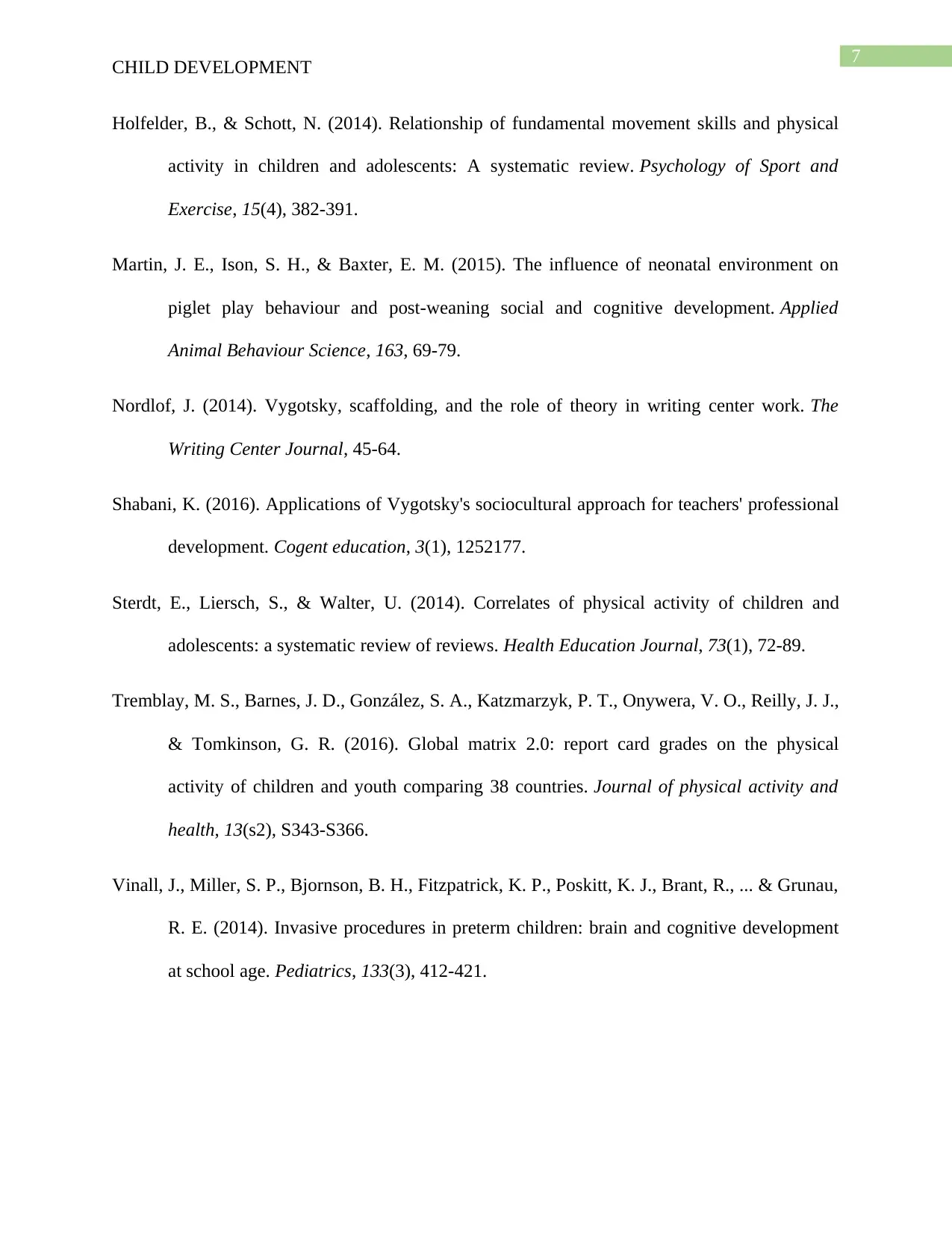
7
CHILD DEVELOPMENT
Holfelder, B., & Schott, N. (2014). Relationship of fundamental movement skills and physical
activity in children and adolescents: A systematic review. Psychology of Sport and
Exercise, 15(4), 382-391.
Martin, J. E., Ison, S. H., & Baxter, E. M. (2015). The influence of neonatal environment on
piglet play behaviour and post-weaning social and cognitive development. Applied
Animal Behaviour Science, 163, 69-79.
Nordlof, J. (2014). Vygotsky, scaffolding, and the role of theory in writing center work. The
Writing Center Journal, 45-64.
Shabani, K. (2016). Applications of Vygotsky's sociocultural approach for teachers' professional
development. Cogent education, 3(1), 1252177.
Sterdt, E., Liersch, S., & Walter, U. (2014). Correlates of physical activity of children and
adolescents: a systematic review of reviews. Health Education Journal, 73(1), 72-89.
Tremblay, M. S., Barnes, J. D., González, S. A., Katzmarzyk, P. T., Onywera, V. O., Reilly, J. J.,
& Tomkinson, G. R. (2016). Global matrix 2.0: report card grades on the physical
activity of children and youth comparing 38 countries. Journal of physical activity and
health, 13(s2), S343-S366.
Vinall, J., Miller, S. P., Bjornson, B. H., Fitzpatrick, K. P., Poskitt, K. J., Brant, R., ... & Grunau,
R. E. (2014). Invasive procedures in preterm children: brain and cognitive development
at school age. Pediatrics, 133(3), 412-421.
CHILD DEVELOPMENT
Holfelder, B., & Schott, N. (2014). Relationship of fundamental movement skills and physical
activity in children and adolescents: A systematic review. Psychology of Sport and
Exercise, 15(4), 382-391.
Martin, J. E., Ison, S. H., & Baxter, E. M. (2015). The influence of neonatal environment on
piglet play behaviour and post-weaning social and cognitive development. Applied
Animal Behaviour Science, 163, 69-79.
Nordlof, J. (2014). Vygotsky, scaffolding, and the role of theory in writing center work. The
Writing Center Journal, 45-64.
Shabani, K. (2016). Applications of Vygotsky's sociocultural approach for teachers' professional
development. Cogent education, 3(1), 1252177.
Sterdt, E., Liersch, S., & Walter, U. (2014). Correlates of physical activity of children and
adolescents: a systematic review of reviews. Health Education Journal, 73(1), 72-89.
Tremblay, M. S., Barnes, J. D., González, S. A., Katzmarzyk, P. T., Onywera, V. O., Reilly, J. J.,
& Tomkinson, G. R. (2016). Global matrix 2.0: report card grades on the physical
activity of children and youth comparing 38 countries. Journal of physical activity and
health, 13(s2), S343-S366.
Vinall, J., Miller, S. P., Bjornson, B. H., Fitzpatrick, K. P., Poskitt, K. J., Brant, R., ... & Grunau,
R. E. (2014). Invasive procedures in preterm children: brain and cognitive development
at school age. Pediatrics, 133(3), 412-421.
1 out of 8
Related Documents
Your All-in-One AI-Powered Toolkit for Academic Success.
+13062052269
info@desklib.com
Available 24*7 on WhatsApp / Email
![[object Object]](/_next/static/media/star-bottom.7253800d.svg)
Unlock your academic potential
© 2024 | Zucol Services PVT LTD | All rights reserved.




